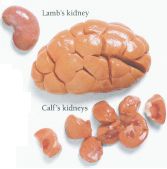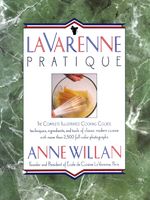Calf’s (or veal) kidney is the top choice for broiling or cooking as a sauté in a dark wine sauce. Bean-shaped lamb’s kidney is the next best thing; it tastes just a little less rich. Pig’s and beef kidneys, often mixed with other ingredients, as in British steak and kidney pie, are well suited to braising and stewing, when they yield a wonderfully rich sauce.
Useful Information
How to choose Fresh, no ammoniac smell. Calf’s: deep pink or beige color, not red. Lamb’s: deep pink color, not red. Pig’s or beef: red color, not black.
Portion Calf’s: one kidney. Lamb’s: 1 ½-2 kidneys. Pig’s or beef: 4-6 oz/125-175 g.
Nutritive value per 3 ½ oz/100 g: 108 calories; 17 g protein; 4 g fat; 1 g carbohydrate; 350 mg cholesterol; 183 mg sodium.
Cooking methods Whole calf’s or lamb’s: braise at 350°F/175°C, 30-45 minutes; roast in fat at 450°F/230°C, 30-40 minutes per 1 lb/500 g; cook as a sauté 15-20 minutes. Sliced calf’s or lamb’s: broil 6-8 minutes; sauté 6-8 minutes. Sliced pig’s or beef: braise or stew at 350°F/175°C, 1 ½-2 ½ hours.
When done Whole: juice runs pink when pierced. Sliced: calf’s and lamb’s kidney should be pink in center; pig’s and beef, very tender.
Problems Ammoniac taste if stale or poorly handled.
Processed forms Frozen.
Storage Refrigerate 1 day.
Typical dishes rognoncini trifolati (sautéed with Marsala, Italy); with tomatoes, olives and hot peppers (USA); sautéed with hard-boiled eggs (Spain); dumplings (UK); in lemon and white wine sauce (Germany); with tomatoes and boletes (France); with mustard and Madeira sauce (France); with pork (Ireland). Also good with ham, mushrooms, red wine, sherry, herbs.



